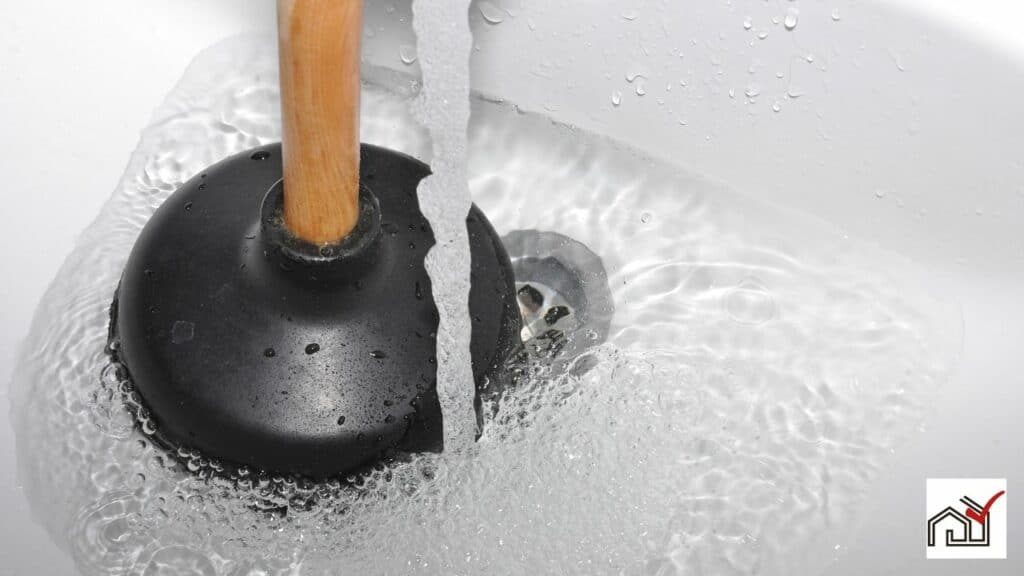To unclog a bathroom sink with vinegar and baking soda, follow these steps:
- Gather your materials: You will need white vinegar, baking soda, boiling water, and a cloth or stopper.
- Pour one cup of baking soda into the drain.
- Follow with one cup of white vinegar. The mixture will fizz, which helps to break down the clog.
- Cover the drain with the cloth or stopper to contain the reaction for 15 minutes.
- Boil a kettle of water and then pour the hot water down the drain to flush out the clog.
- If the sink is still clogged, repeat the process.
This method is typically safe for plumbing but may not work on all types of clogs. If the clog persists, consider consulting a professional plumber.
Regular use of this mixture can help maintain clear drains.
Understanding Sink Clogs
Sink clogs occur when substances accumulate in the drain over time. Hair, soap scum, and toothpaste often block bathroom sinks, while kitchen sinks get clogged by food particles and grease. These substances stick to pipe walls, causing clogs.
To clear a clog, a common method involves using baking soda and vinegar. Mixing baking soda with vinegar triggers a reaction that produces carbon dioxide and water. This reaction can dislodge the blockage in the drain.
Using hot water with baking soda and vinegar can improve the unclogging process. Hot water dissolves fats and soap, helping to clear the pipes. Regular use of hot water also prevents future clogs by reducing mineral and residue buildup.
Necessary Materials
To unclog a bathroom sink with vinegar and baking soda, you need baking soda, white or apple cider vinegar, boiling water, and a cloth or drain plug.
Baking soda helps loosen dirt, and vinegar breaks it down.
Mix half a cup of baking soda with an equal amount of vinegar, cover the drain to keep the reaction inside the pipes, and let it sit for an hour.
Then, pour boiling water down the drain to clear debris.
If necessary, add a few drops of dish soap for greasy clogs.
If the clog persists, professional help may be required.
Preliminary Steps
To unclog a sink, start by pouring dish soap down the drain to break down grease. After letting the soap sit, follow with boiling water to wash away the grease and soap.
Next, ensure the sink is dry before pouring a cup of baking soda down the drain. Cover the drain with a cloth to focus the cleaning reaction downward. Allow the mixture to sit and work on the clog.
Using this method of dish soap, boiling water, and baking soda can clear minor sink blockages.
Application Process
Begin by pouring one cup of baking soda into the drain, followed by one cup of distilled white vinegar. The combination will fizz, helping to break down the clog. Do not use the sink during this reaction. Wait at least five minutes before proceeding, which allows the mixture to work on the clog.
If the drain is still slow after the initial treatment, repeat the process.
Conclude by flushing the drain with two cups of boiling water to remove any remaining debris.
If the clog persists after two attempts, consider alternative methods or contact a professional plumber.
Aftercare and Maintenance
After unclogging the bathroom sink, it's important to maintain it to prevent future blockages. Regular maintenance not only helps avoid further clogs but also prolongs the plumbing's lifespan. Experts recommend preventative measures as the best approach.
To maintain the bathroom sink, flush it with hot water weekly to dissolve grease and remove debris. Use a drain strainer to catch hair and particles that can cause clogs. Never pour grease and oil down the sink; dispose of them in the trash. If you have a garbage disposal, run cold water while using it to help break down fats and oils.
Clean the sink and surrounding area regularly with a mix of warm water and dish soap to prevent buildup and maintain freshness. Following these steps will keep your bathroom sink in good working condition and reduce the likelihood of future clogs.
Preventative Measures
Regular cleaning and the use of drain strainers are important for preventing bathroom sink clogs. Weekly flushing with hot water can dissolve grease and debris. This reduces the need for unclogging with vinegar and baking soda, which can be used for deeper cleaning.
Drain strainers catch hair and soap, preventing blockages. Proper disposal of grease, oil, and food scraps in the trash also helps prevent clogs.
Using cold water in the garbage disposal solidifies fats and oils, preventing them from sticking to pipes. These practices have been proven effective in maintaining bathroom sink drains.
Adopting regular maintenance prevents frequent clogs and helps keep bathroom sinks in good condition.





